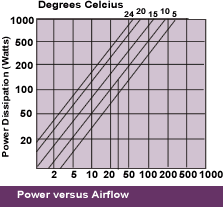Equations and Variables:
Maximum static pressure and maximum air volume measurements must be taken separately.
Maximum Static Pressure Measurement:
When the nozzle is closed, the pressure in chamber A will reach a maximum. The pressure difference Ps represents the maximum static pressure achievable by the fan.
Maximum Air Volume Measurement:
The nozzle is opened and the auxiliary blower is used to lower the pressure in chamber A to Ps = 0. The maximum air volume can then be calculated using Pn, D and the air volume equation below. Q represents the maximum achievable airflow with the fan in free air.
Q = 3.16W / Tf or Q = 1.76W / Tc
Q = Airflow required in CFM (cubic feet per minute)
W = Heat dissipated in watts
Tc = Temperature rise above inlet temp °C
Tf = Temperature rise above inlet temp °F
 Using the chart above, one can estimate the airflow required. The vertical axis represents the heat to be removed and the horizontal axis represents the airflow. Notice that both axes are logarithmic. The sloping lines define the temperature rise in °C. First find the sloping line that represents the permitted rise, and then find the point on this line that corresponds to the heat to be removed. The horizontal position of this point shows the required airflow.
Using the chart above, one can estimate the airflow required. The vertical axis represents the heat to be removed and the horizontal axis represents the airflow. Notice that both axes are logarithmic. The sloping lines define the temperature rise in °C. First find the sloping line that represents the permitted rise, and then find the point on this line that corresponds to the heat to be removed. The horizontal position of this point shows the required airflow.
For example, 35 CFM of airflow is required for a system that dissipates 200W, which results in a 10°C temperature rise.
